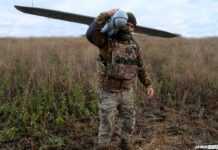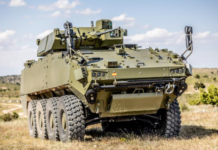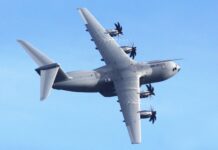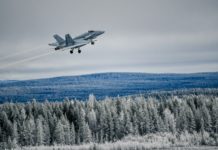Larger airborne early warning and surveillance systems on multi-engine aircraft and helicopters have to meet increasing demands to locate ever smaller targets like periscopes or small UAVs. At the same time, some platforms are becoming increasingly more expensive to operate and are earmarked to be replaced, or at least life-extended through various modernisation programmes. According to various market forecasts, the global military airborne radar market is expected to grow at a Compound Annual Growth Rate (CAGR) of 3.8 per cent to a value of US$4.2Bn by 2029. The segment of airborne fire-control radars (on fighters) is expected to gain or cover ~50 per cent of that figure.
Until the end of the decade, North America is predicted to dominate the sector with ~40 per cent, followed by the Asia-Pacific region (China, India, South Korea and Australia) and Europe, with shares of ~27 per cent and ~20 per cent respectively. In this segment, we meet all the ”big players” like Lockheed Martin, Northrop Grumman, Raytheon and L3Harris Technologies (all US), Thales Group (France), IAI, ELTA and Elbit (all Israel), Leonardo SPA (Italy and UK), BAE Systems (UK), Hensoldt AG (Germany) or Saab AB (Sweden), but also Turkish Aselsan or – while mainly concentrated on its own forces – subsidiaries of Russia‘s Rostec (like JSC Radar-MMS) or Chinese laboratories and manufacturers equipping KJ-500 and KJ-2000 under the roof of the state-run AVIC.
Wide Variety of Tasks
While rotating antennas on Airborne Early Warning & Control Aircraft (AEW&C) like the USAF- and NATO-operated E-3A AWACS (E3-D in UK) on vintage Boeing 707/320s have been around for decades, these aircraft were recently accompanied – or even challenged – by emerging multi-mission surveillance systems mounted on much cheaper to operate business jet and commuter platforms. Like Saab’s GLOBAL EYE for the UAE Air Force and included in its Finnish HX-offer, its ERIEYE bar on various Embraer-145 twin-jets (as in Greece or Brazil) or fuselage-conformal systems preferred by IAI (as on the latest Israeli ORON or G550-platforms for Italy). Altogether, their integrated sensor suite offers exceptional air defence and air battle-management capability, with accurate and reliable high-altitude long-range continuous 360° azimuthal surveillance of all airborne and maritime threats. The later AEW&C aircraft are equipped with the latest generation of Gallium Nitride (GaN) AESA-radar, integrated with other advanced ISR-sensor-systems. Furthermore, the mission sets are long-range air- and maritime-surveillance able to deliver situation awareness, electronic order of battle-management and generation, air defence C2, network-centric warfare operations or communications/relay node in information dissemination. For that, they also usually utilise IFF, SIGINT and sophisticated encrypted communication systems, to generate and disseminate an air and maritime situation picture.
Prime Targets
Since – as is the case with tanker aircraft – being a critical, high-value force multiplier in any scenario, these normally highly expensive aircraft are also prime targets for opposing forces and need to maintain a certain distance from so-called hot air spaces. Subsequently and unsurprisingly, Russia, and also China are at the forefront – in line with their anti-access/area denial mantra – of developing and fielding ultra-long range air-to-air missiles, with (albeit claimed) ranges up to 400 km, such as the Chinese PL-21 or the Russian R-37M. This effort fits well with the fact that their stealth fighters like the J-20 or Su-57 respectively, are designed to be low-observable in the frontal aspects in particular, in order to get close(r) to the enemy‘s high-prize assets before launching. To the author, it has been confirmed by UAEAF officers that a ’healthy‘ separation distance and vigilant onboard fighter-control officers act as their ’last line of defence‘, that is, if their own fighters are operating in a Combat Air Patrol role at a realistically manageable distance for Quick Reaction Alert-readiness state. This would be the case for all US E-3s, Japanese 767-AWACS, or Australian E-737s, not least since their own escorts might not have sufficient range capability…
Developments, Replacement and Modernisation efforts
The oldest airborne radar system (and airframe) – which has pioneered this segment – is the original line-up of 18 Boeing E-3As (now reduced to 14), with the component directly supported by Belgium, Canada, the Czech Republic, Denmark, Germany, Greece, Hungary, Italy, Luxembourg, the Netherlands, Norway, Poland, Portugal, Romania, Spain, Turkey, and the US. They are built around a 9.1 m-diameter rotating radome that has a range of more than 400 km (which results in coverage of more than 500,000 km2 of airspace) to look down, detect, identify, and track low-flying aircraft over land or water. Leonardo announced on 21 May that it has been contracted by Boeing as the prime contractor for the NATO AEW&C programme-management agency to upgrade the first NATO E-3A test aircraft. The contract, which is to be completed by 2023, includes the installation of newly-developed hardware under a FLEP-programme and will be carried out at their Venice-Tessera plant in Italy. It was, however, not specified when the upgrade is planned to be rolled out to the remaining 13 NATO aircraft. NATO plans to spend US$1Bn for a final life- extension of the aircraft, which would keep it flying until 2035. Last June, a first indication of a distant replacement was mentioned, when a NATO official said that a replacement for the AWACS could include different combinations of systems in the air, on land, at sea, in space and in cyberspace. The aim is for the solution to be ready by 2035, when the E-3 airframes need to be retired. Likely contenders would (again) be Boeing and Northrop Grumman and European Saab and/or Airbus – or any joint transatlantic solution.
An indication of where it might be stationed comes from the UK, where the RAF’s E-3Ds, flown out of RAF Waddington by 8 Squadron, are due to be retired later this year and replaced by the E-7A WEDGETAIL with its fixed radar-bar from 2023 on. Boeing UK announced late last November that the first fuselage sections for the first two aircraft to be modified had been delivered to STS Aviation Services in Birmingham. The fleet of RAF Global Express-based Raytheon SENTINEL R1 Airborne Stand-Off Radar (ASTOR) wide-area ground-surveillance aircraft have already been retired, and are likely to be replaced by either the unmanned General Atomics‘ PROTECTOR RG1 from about 2024, or partly by the Boeing E-737, also operated by the air forces of Australia, Turkey and South Korea. In the US, Gen. Kenneth S. Wilsbach, head of the US Pacific Air Forces made the call this February for acquiring the E-7s to support, or later replace the USAF’s ageing E-3A fleet.
In the meantime, it is worth noting he successful transfer of the UAE’s AEW-component from two small Saab-340-based ERIEYE to (now five) top class Saab GLOBALEYE multi-mission surveillance platforms. Sweden’s Saab has received the much-anticipated option now bearing fruit in the form of a follow-on order by the UAE (worth US$1Bn) for two additional GLOBALEYE aircraft this January. It is an extension of a 2015 deal for three units, made up of Bombardier GLOBAL 6000 business-jets equipped with Saab’s latest ERIEYE long-range radar and other surveillance sensors. The UAE’s military received its first GLOBALEYE from the original deal in the spring of 2020, just as the COVID-19 crisis was just beginning to bite. In general, the GLOBAL 6000 VIP series are looking to continue to becoming popular platforms for intel-gathering and early radar-warning. A year ago, the German Government ditched plans to buy US Navy TRITON drones for SIGINT collection, choosing instead to install the requisite sensing equipment on similar manned jets. Also last year, Saab landed a secretive AEW&C deal worth SKr1.6Bn (US$165M) for an undisclosed number of its turboprop Saab-2000 ERIEYE AEW&C aircraft. It could be a follow-on order for Pakistan.
Israel Aerospace Industries (IAI) is one of a select few companies which possesses all the necessary technology capabilities in-house which achieved a major breakthrough in AEW and Special Mission Aircraft, thanks to advanced sensor miniaturisation technology coupled with Artificial Intelligence (AI) and machine learning software applications, allowing high-performance business jets to be used as Special Mission Aircraft. Last year, it received a US$350M contract from what they named as a ”a major European country”. Last December, the US State Department issued an approval for the FMS-sale of two G550 AEW/ISR to the Italian Government, with L3Harris at Greenville, Texas, acting as prime contractor and system installer. They are expected to resemble the SHAVITS operated by Israel. Australia has also ordered four L3Harris-modified versions, which will be known as the MC-55A PEREGRINE. ELTA’s CAEW (Conformal Airborne Early Warning) aircraft are fitted with dual band AESA-radars, providing uncompromised 360° azimuthal coverage. IAI has also entered into cooperation agreements with Airbus and Embraer to develop and market additional AEW&C aircraft variants.
Furthermore, last December, the Indian MoD Defence Research and Development Organisation (DRDO) was allowed to convert six former Air India A320 family aircraft into advanced airborne-radar carriers that are able to ”peek deep inside China or Pakistan to alert the authorities“. This alters plans from 2015 to acquire two brand new AWACS based on the much bigger Airbus A330 platform. The aircraft would be sent to France where the modifications would be carried out and the AWACS delivered to the IAF up to seven years from now. Currently, since 2009, the IAF operates three IL-76 based IAI PHALCON AWACS and two home-made Embraer EMB-145-mounted NETRA airborne radars with limited ability. The NETRA – delivered after nearly two decades by DRDO in 2015 – has limitations in terms of vision and capability. Unlike the 360° capability of the PHALCON, the NETRA cannot see all around, as its radar has only 240° coverage. In contrast, its potential opponents in the Chinese PLAAF has nearly 20 airborne radars with 360° view, whereas Pakistan has eight such platforms.
Radar-MMS from St. Petersburg is maybe the most prominent Russian designer, manufacturer and system integrator of avionics suites for airborne radar and monitoring equipment in AEW-, patrol- and special-mission aircraft. Since 2011, the Russian VKS has operated 16 Il-76/PS90-based BERIEV A-50U (NATO: MAINSTAY) AEW&C aircraft, one – in the later version‘s distinctive dark-grey scheme – was just this May seen accompanying three Tu-22M3 BACKFIRE-C swing-wing bombers deployed to Khmeimim Air Base in Syria.
Helicopter AEW Systems
As a consequence of lessons learnt by the Royal Navy during the 1982 Falklands War when the lack of AEW coverage for the Task Force represented a major tactical handicap, essentially rendering its ships vulnerable to low-level Argentinian air-attack, the Westland AEW SEA KING AEW.2 and .5 and later the ASaC7 naval helicopter-based radar was developed and operated from both the INVINCIBLE class aircraft carriers and later the helicopter carrier HMS OCEAN. They carried the Thorn-EMI ARI 5980/3 SEARCHWATER and later SEARCHWATER 2000 radar, attached to the fuselage on a swivel arm and protected by an inflatable dome. The latter was capable of simultaneously tracking up to 400 targets, instead of 250 previously. The Spanish Armada fields the SH-3 SEA KING in the same role, operated from the JUAN CARLOS I. Meanwhile, since 2010, the Royal Navy has begun to replace these with the CROWSNEST system fitted to some of their MERLIN HM.2 fleet. It sailed on 1 May with the new carrier QUEEN ELIZABETH on a 26,000 mile deployment to the Indian and Pacific Oceans. The Italian Navy, from its aircraft carriers CAVOUR and GIUSEPPE GARIBALDI operates the EH-101AEW. The Russian-built KAMOV Ka-31 is deployed by the Indian Navy on the carrier INS VIKRAMADITYA and TALWAR class frigates and will be deployed on the new INS VIKRANT. The Russian Navy has two Ka-31R variants, at least one of which was deployed on their carrier ADMIRAL KUZNETSOV to the Mediterranean in 2016. It is fitted with the E-801M OKO (Eye) airborne electronic warfare radar that can track 20 targets simultaneously, detecting aircraft up to 150 km away and surface warships up to a range of 200 km.
This article originally appeared in the July issue of European Security & Defence. Click here to download the full issue in PDF format.











